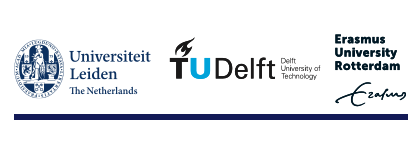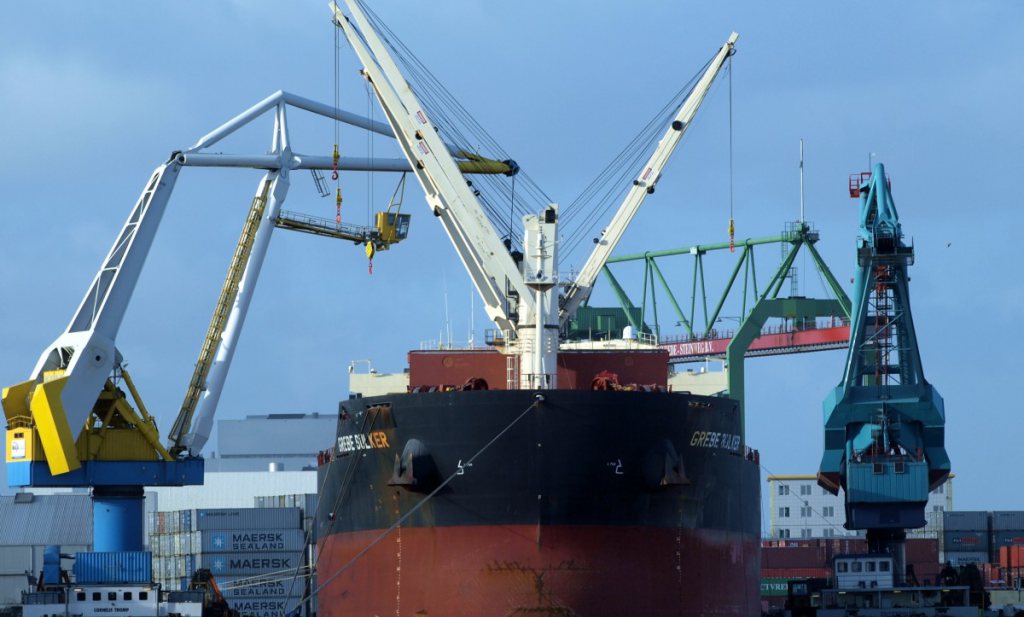The Port of Amsterdam is the world's largest port for cocoa. This flow of goods is so substantial that the port is seizing the opportunity to introduce its own sustainability standard. Mark Hoolwerf, area manager of the Amsterdam Port Authority (Port of Amsterdam) explains why the port interferes with the activities of companies in the port.
Amsterdam is 'a city with a port,' says Mark Hoolwerf. The reverse is true for Rotterdam, which is 'a port with a city'. In terms of 'throughput', the amount of goods the port handles, the ports of Rotterdam and Amsterdam are incomparable. Rotterdam handles some 400 million tonnes annually, Amsterdam 'only' 78. By way of comparison, Antwerp handles around 200 million tonnes.
The Port of Amsterdam is characterised by a specific flow of goods: cocoa. Trade in the raw material for chocolate makes the port of Amsterdam the largest cocoa port in the world. Cocoa beans arrive in the big port of Rotterdam and are shipped through, by barges, to Amsterdam, where they are stored before being processed by the processors around Zaanstad and re-exported as (semi-)finished products.
The main customers of the Port of Amsterdam are storage companies, transhipment companies, and processors. On the port site, they store, for example, cocoa beans (which belong to third parties), or coal and petroleum (at the moment, energy accounts for two-thirds of port activity). Long-term contracts are entered into for this storage and transhipment. A concession for storage may run for 50 years. Because space is scarce, so close to Amsterdam, the port can impose specific requirements on companies wishing to rent space there. That is not just anything. The Port of Amsterdam wants to be an involved chain partner, but is in fact a landlord. Involvement in the activities of tenants is quite revolutionary. After all, many of the goods come from far away and are purchased by processors, who strive towards fulfilling their own goals in the supply chain. What influence can a port authority exert?
Ambitions
A few years ago, the Port of Amsterdam started formulating its own ambitions for a Supply Chain Agenda. ‘Less fossil, more agriculture’ was one of the starting points. Another important point, ‘a fair price for (small) suppliers of bulk goods’. The port wants to free up 25 hectares for companies that contribute to a circular economy. Another 45 hectares are intended for companies that contribute to the transition to a sustainable economy. Based on these ambitions, a new ‘establishment policy’ has been adopted, in which corporate social sustainability (CSR) takes a key role. Companies that want to establish themselves have to own up whether their ambitions match those of the port. If not, what steps can they take to make them fit the sustainability requirements set by the Port Authority?
Mark Hoolwerf on the ambitions of the Port of Amsterdam, Digital Food use case.
How does the Port of Amsterdam set its requirements?
In collaboration with Wageningen University & Research, the Port of Amsterdam is contributing to the development of a Dashboard that should provide insight into the sustainability of goods flows, including palm oil and soy. Currently, there exist some 60 different standards, for soy alone. Are all these standards adequately safeguarded and independent? Which standards offer sufficient protection for farmers or the environment? Finally, which standards does the Port of Amsterdam want to hold its clients to and what do they themselves think? After all, the Port is dependent on the organisations (NGOs) that set the standards and on their users.
For the time being, the Port Authority is not making bold choices. The Port Authority's new concession contracts require tenants to meet at least ‘one’ standard. According to Hoolwerf, large companies are pleased with that notion; it gives them a level playing field. Even though they differ from one standard to another, the standards themselves are transparent. The Port Authority can therefore provide insight into which volumes have passed through the port on the basis of specific sustainability requirements.
The port has adopted the so-called 'Structural Due Diligence' approach. All goods shipped through the port must be assessed for their contribution to a more sustainable and fairer world, in which farmers in low-wage countries are not underpaid. By sharing data in the Dashboard mentioned above, insight is created from which all parties can learn. Not only does this make it easier for the Port of Amsterdam to choose the 'right' tenant, but other producers and ultimately, the consumer, will also reap the benefits. After all, all parties are committed to working towards the same goals.
Is a standard adjusted or new legislation introduced? It is then relatively easy to move up to a higher level together, in an ‘ecosystem’ of companies committed to sustainability. The Port of Amsterdam is taking small steps towards making the cluster of companies working there more sustainable. At the same time, it is working on creating a sustainable brand. If it succeeds in keeping to this path, a cluster of processing and trading companies will arise in and around Amsterdam, all of which buy their overseas goods sustainably. Products made and processed in Amsterdam will then become a hallmark of being sustainable.
Are there other port companies in the world with a similar policy? The answer consists of two letters: no.
The Port of Amsterdam is characterised by a specific flow of goods: cocoa. Trade in the raw material for chocolate makes the port of Amsterdam the largest cocoa port in the world. Cocoa beans arrive in the big port of Rotterdam and are shipped through, by barges, to Amsterdam, where they are stored before being processed by the processors around Zaanstad and re-exported as (semi-)finished products.
The main customers of the Port of Amsterdam are storage companies, transhipment companies, and processors. On the port site, they store, for example, cocoa beans (which belong to third parties), or coal and petroleum (at the moment, energy accounts for two-thirds of port activity). Long-term contracts are entered into for this storage and transhipment. A concession for storage may run for 50 years. Because space is scarce, so close to Amsterdam, the port can impose specific requirements on companies wishing to rent space there. That is not just anything. The Port of Amsterdam wants to be an involved chain partner, but is in fact a landlord. Involvement in the activities of tenants is quite revolutionary. After all, many of the goods come from far away and are purchased by processors, who strive towards fulfilling their own goals in the supply chain. What influence can a port authority exert?
Ambitions
A few years ago, the Port of Amsterdam started formulating its own ambitions for a Supply Chain Agenda. ‘Less fossil, more agriculture’ was one of the starting points. Another important point, ‘a fair price for (small) suppliers of bulk goods’. The port wants to free up 25 hectares for companies that contribute to a circular economy. Another 45 hectares are intended for companies that contribute to the transition to a sustainable economy. Based on these ambitions, a new ‘establishment policy’ has been adopted, in which corporate social sustainability (CSR) takes a key role. Companies that want to establish themselves have to own up whether their ambitions match those of the port. If not, what steps can they take to make them fit the sustainability requirements set by the Port Authority?
Mark Hoolwerf on the ambitions of the Port of Amsterdam, Digital Food use case.
How does the Port of Amsterdam set its requirements?
In collaboration with Wageningen University & Research, the Port of Amsterdam is contributing to the development of a Dashboard that should provide insight into the sustainability of goods flows, including palm oil and soy. Currently, there exist some 60 different standards, for soy alone. Are all these standards adequately safeguarded and independent? Which standards offer sufficient protection for farmers or the environment? Finally, which standards does the Port of Amsterdam want to hold its clients to and what do they themselves think? After all, the Port is dependent on the organisations (NGOs) that set the standards and on their users.
For the time being, the Port Authority is not making bold choices. The Port Authority's new concession contracts require tenants to meet at least ‘one’ standard. According to Hoolwerf, large companies are pleased with that notion; it gives them a level playing field. Even though they differ from one standard to another, the standards themselves are transparent. The Port Authority can therefore provide insight into which volumes have passed through the port on the basis of specific sustainability requirements.
If the Port succeeds in following this path, a cluster of processing and trading companies will arise in and around Amsterdam, all buying their overseas goods sustainablyStructural Due Diligence
The port has adopted the so-called 'Structural Due Diligence' approach. All goods shipped through the port must be assessed for their contribution to a more sustainable and fairer world, in which farmers in low-wage countries are not underpaid. By sharing data in the Dashboard mentioned above, insight is created from which all parties can learn. Not only does this make it easier for the Port of Amsterdam to choose the 'right' tenant, but other producers and ultimately, the consumer, will also reap the benefits. After all, all parties are committed to working towards the same goals.
Is a standard adjusted or new legislation introduced? It is then relatively easy to move up to a higher level together, in an ‘ecosystem’ of companies committed to sustainability. The Port of Amsterdam is taking small steps towards making the cluster of companies working there more sustainable. At the same time, it is working on creating a sustainable brand. If it succeeds in keeping to this path, a cluster of processing and trading companies will arise in and around Amsterdam, all of which buy their overseas goods sustainably. Products made and processed in Amsterdam will then become a hallmark of being sustainable.
Are there other port companies in the world with a similar policy? The answer consists of two letters: no.
Related



